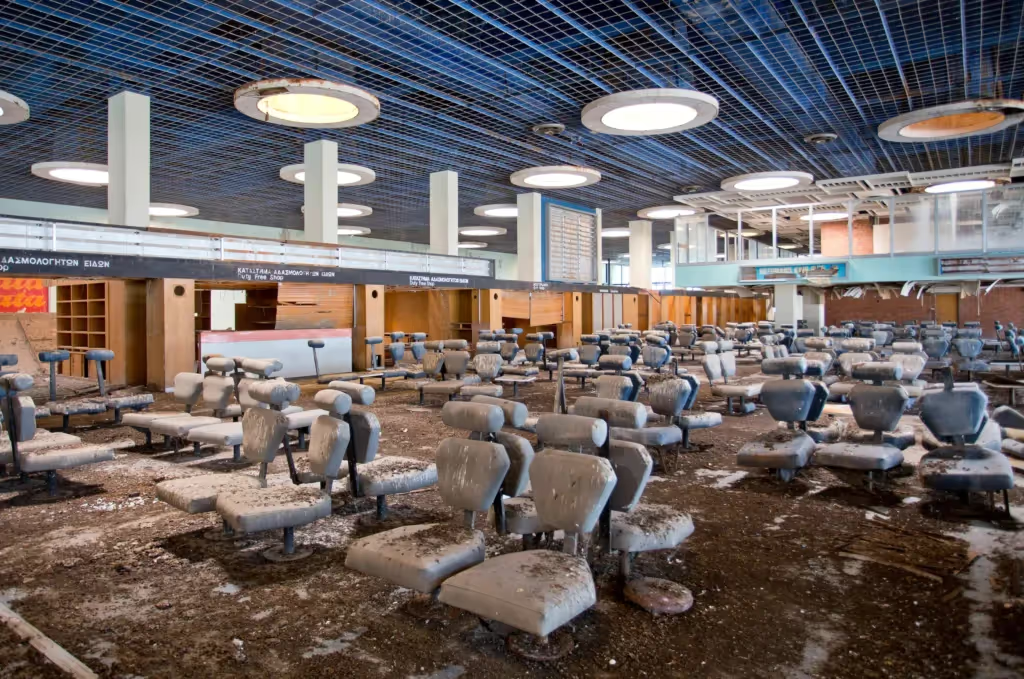
Abandoned places – whether they be castles in France, once-opulent hotels in Croatia, or full-on international airports in Cyprus – all offer a peek into the past. These structures, which were once homes, gathering places, or something in between, now stand as eerie spots that each tell a unique story. Ahead, learn more about the coolest (and creepiest) abandoned buildings around the world.

Haludovo Palace Hotel (Malinska, Croatia)
In the summer of 1972, the Haludovo Palace Hotel opened its doors to the wealthiest of the West. Funded by the owner of "Penthouse" magazine, this hotel, complete with a casino, was predicted to compete with Las Vegas. But, due to a lack of foreign visitors, it faced financial struggles one year after opening. Mixed with that and a civil war in the area, the hotel has since been empty and has no plans for redevelopment.

Château de la Mothe-Chandeniers (Les Trois-Moutiers, France)
Located in the Loire Valley, Château de la Mothe-Chandeniers dates back to the 13th century. This stunning château has witnessed centuries of both luxuriousness and turmoil after changing hands among noble families. However, a fire in 1932 left the château in ruins, which led to its abandonment. For decades, the castle stood empty, but recently, a crowdfunding campaign successfully raised enough money to restore it.

Bodiam Castle (Bodiam, England)
Built in 1385, this castle (which has a medieval moat) was designed as a defense against French invasion during the Hundred Years' War as well as a residence. Over the centuries, the castle changed hands before becoming abandoned in the 17th century. In the early 20th century, the castle was bought and restored. Today, it’s managed by the National Trust and stands as a well-preserved ruin.

The Maunsell Sea Forts (Thames Estuary, Great Britain)
Constructed during World War II, the Maunsell Sea Forts were designed to defend against German air and naval attacks. Each of these fortified towers consisted of a cluster of interconnected steel platforms, which housed anti-aircraft guns and radar equipment. After the war, the forts were decommissioned and abandoned.

Nicosia International Airport (Nicosia, Cyprus)
Once the primary airport of Cyprus, Nicosia International Airport has drastically changed. In 1974, the airport became a casualty of the Turkish invasion of Cyprus, which followed a coup d'état by Greek Cypriot nationalists. The conflict led to the airport being severely damaged and subsequently abandoned.

Six Flags (New Orleans, Louisiana)
Originally opened as Jazzland in 2000 and then acquired and rebranded by Six Flags in 2003, this park was once a fun attraction. In August 2005, Hurricane Katrina tore through the city, leaving the park under floodwaters for weeks, which caused extensive damage. Following the disaster, Six Flags declared the park a loss and decided not to rebuild.

City Hall Subway (New York, New York)
Opened in 1904 as part of the city's first subway line, the City Hall Subway was designed to be a showpiece featuring Guastavino tile arches, skylights, and brass chandeliers. However, the station's curved platform (which is gorgeous) could not accommodate newer, longer trains, which led to its closure in 1945. Now, it remains closed to the public but is occasionally opened for special tours.

Villa Epecuén (Buenos Aires Province, Argentina)
Established in the 1920s as a tourist village on the shores of Lago Epecuén, Villa Epecuén became a popular destination known for its saltwater lake. That all changed in 1985, after a combination of heavy rains and infrastructure failures caused the lake to overflow, submerging Villa Epecuén under nearly 30 feet of water. The town was abandoned, and for over two decades, it lay underwater, its buildings slowly decaying. In recent years, the waters have receded, revealing the eerie remnants of the town.

New York State Pavilion (Queens, New York)
The New York State Pavilion was designed for the 1964-65 New York World's Fair. It featured the "Tent of Tomorrow," a huge pavilion with a distinctive roof supported by 16 concrete columns. After the structure fell into disrepair in the years after the fair, the New York City Department of Parks and Recreation took it over, and it now remains a beloved structure in Queens.

Hotel Del Salto (Tequendama Falls, Colombia)
Located on the edge of a cliff overlooking the Tequendama Falls, the Hotel Del Salto is as chilling as it is intriguing. Opened in 1928, this luxury hotel was a place where the wealthy would flock, thanks to its stunning views and opulent interior. However, pollution of the Bogotá River led to fewer visitors over the years and by the early 1990s, the hotel closed and became abandoned. Now, it stands as the Tequendama Falls Museum of Biodiversity and Culture, which helps raise awareness about the region's ecological challenges.






.jpg)




.jpg)



.jpeg)